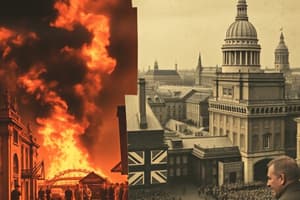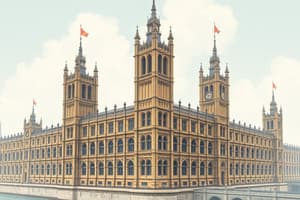Podcast
Questions and Answers
What was the significance of Londinium in Roman Britain?
What was the significance of Londinium in Roman Britain?
- A Roman military outpost in Britain
- A key Roman city in Britain and a prominent trade center (correct)
- The Roman capital city in Britain
- The smallest answer in Roman Britain
What is the name of the historic fortress built in 1078 in London?
What is the name of the historic fortress built in 1078 in London?
- The London Castle
- The Buckingham Palace
- The Windsor Castle
- The Tower of London (correct)
What is the name of the public space in London, home to the National Gallery and Lord Nelson's column?
What is the name of the public space in London, home to the National Gallery and Lord Nelson's column?
- Leicester Square
- Trafalgar Square (correct)
- Piccadilly Circus
- Hyde Park
Since when has Buckingham Palace been the official residence of the British monarch?
Since when has Buckingham Palace been the official residence of the British monarch?
What is the name of the ceremony where the Old Guard hands over responsibility to the New Guard at Buckingham Palace?
What is the name of the ceremony where the Old Guard hands over responsibility to the New Guard at Buckingham Palace?
What is the predominant language spoken in the UK?
What is the predominant language spoken in the UK?
Which of the following is a popular sport in the UK?
Which of the following is a popular sport in the UK?
In what century was the Houses of Parliament built in London?
In what century was the Houses of Parliament built in London?
Flashcards are hidden until you start studying
Study Notes
London History
- Roman Era: Londinium, established in 43 AD, was an important Roman city in Britain.
- Medieval Period: London became a significant trade center, and the City of London Corporation was established in 1130.
- Tudor and Stuart Periods: London grew as a cultural and economic hub, with the establishment of the Royal Exchange (1565) and the first English theater (1576).
- Industrial Revolution: London's population grew rapidly, and the city became a center for trade, commerce, and industry.
London Landmarks
- The Tower of London: A historic fortress built in 1078, home to the Crown Jewels and the Yeoman Warders (Beefeaters).
- Big Ben and the Houses of Parliament: The iconic clock tower and the seat of the UK government, built in the 19th century.
- London Bridge: A historic bridge over the River Thames, with various incarnations since Roman times.
- Trafalgar Square: A vibrant public space, home to the National Gallery and the imposing Lord Nelson's column.
Buckingham Palace
- Royal Residence: The official residence of the British monarch since 1837.
- State Rooms: Used for official events and receptions, featuring opulent decorations and artwork.
- Gardens: The palace's gardens, covering 16 hectares, are a tranquil oasis in the heart of London.
- The Changing of the Guard: A daily ceremony, where the Old Guard (soldiers currently on duty) hand over responsibility to the New Guard.
UK Culture
- Language: English is the predominant language, but the UK is a multilingual society with diverse regional languages and dialects.
- Cuisine: Traditional dishes include fish and chips, roast beef, and full English breakfasts.
- Arts and Literature: The UK is home to a rich cultural heritage, with famous authors like Shakespeare, Dickens, and Austen.
- Sports: Football (soccer), cricket, rugby, and tennis are popular sports in the UK.
British Government
- Parliamentary System: The UK has a parliamentary democracy, with a constitutional monarch as head of state.
- House of Commons: The lower chamber, comprising 650 Members of Parliament (MPs) elected by the people.
- House of Lords: The upper chamber, comprising appointed peers and bishops, reviewing and amending legislation.
- Prime Minister: The head of government, responsible for executing policy and advising the monarch.
London History
- Londinium, established in 43 AD, was an important Roman city in Britain, marking the beginning of London's history.
- In 1130, the City of London Corporation was established, making London a significant trade center during the Medieval Period.
- During the Tudor and Stuart Periods, London grew as a cultural and economic hub, with the establishment of the Royal Exchange in 1565 and the first English theater in 1576.
- The Industrial Revolution saw London's population grow rapidly, transforming the city into a center for trade, commerce, and industry.
London Landmarks
- The Tower of London, built in 1078, is a historic fortress that serves as home to the Crown Jewels and the Yeoman Warders (Beefeaters).
- Big Ben and the Houses of Parliament, built in the 19th century, are iconic landmarks that house the seat of the UK government.
- London Bridge has undergone various incarnations since Roman times, serving as a historic bridge over the River Thames.
- Trafalgar Square is a vibrant public space that is home to the National Gallery and the imposing Lord Nelson's column.
Buckingham Palace
- Buckingham Palace has served as the official residence of the British monarch since 1837.
- The State Rooms are used for official events and receptions, featuring opulent decorations and artwork.
- The palace's gardens cover 16 hectares, providing a tranquil oasis in the heart of London.
- The Changing of the Guard is a daily ceremony where the Old Guard hands over responsibility to the New Guard.
UK Culture
- English is the predominant language, but the UK is a multilingual society with diverse regional languages and dialects.
- Traditional dishes include fish and chips, roast beef, and full English breakfasts.
- The UK is home to a rich cultural heritage, with famous authors like Shakespeare, Dickens, and Austen.
- Football (soccer), cricket, rugby, and tennis are popular sports in the UK.
British Government
- The UK has a parliamentary democracy, with a constitutional monarch as head of state.
- The House of Commons is the lower chamber, comprising 650 Members of Parliament (MPs) elected by the people.
- The House of Lords is the upper chamber, comprising appointed peers and bishops, reviewing and amending legislation.
- The Prime Minister is the head of government, responsible for executing policy and advising the monarch.
Studying That Suits You
Use AI to generate personalized quizzes and flashcards to suit your learning preferences.




